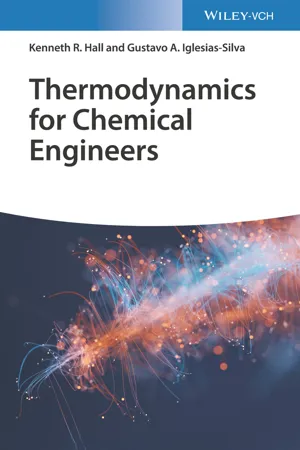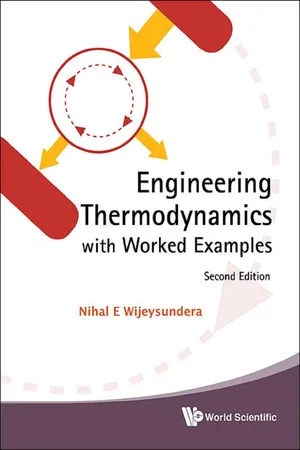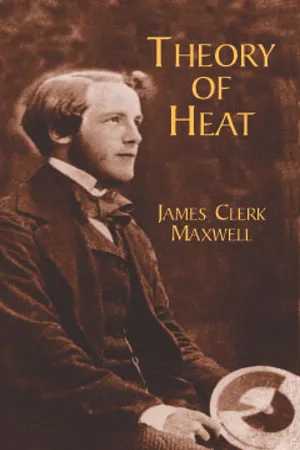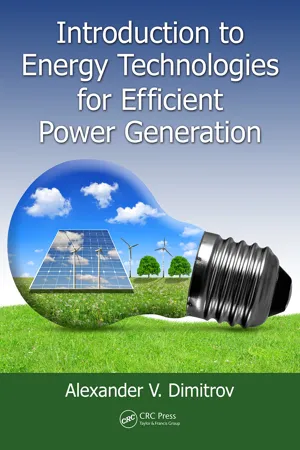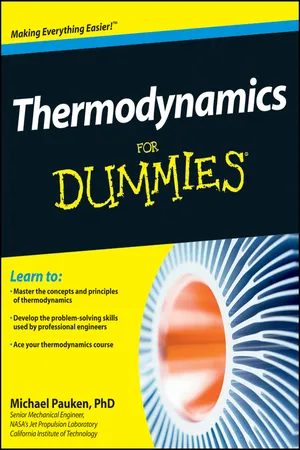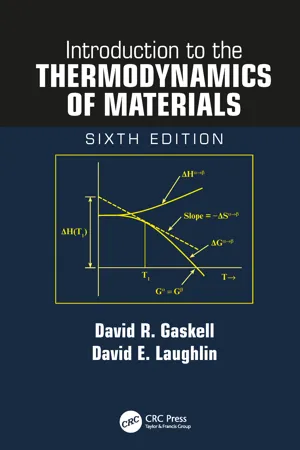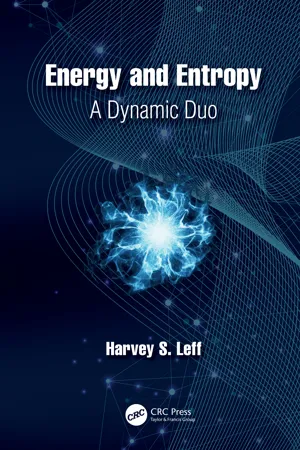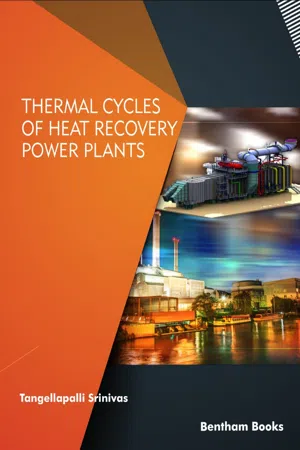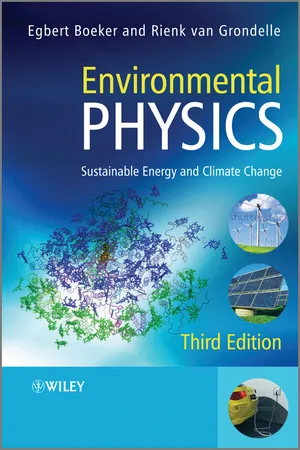Physics
Reversed Heat Engines
Reversed heat engines are devices that operate in the opposite direction of traditional heat engines, converting work into heat rather than heat into work. They are based on the principle of thermodynamic reversibility and are used in theoretical studies and practical applications such as refrigeration and heat pumps. Reversed heat engines play a crucial role in understanding the fundamental principles of thermodynamics.
Written by Perlego with AI-assistance
Related key terms
11 Key excerpts on "Reversed Heat Engines"
- eBook - ePub
- V. Babu(Author)
- 2019(Publication Date)
- CRC Press(Publisher)
A close examination of these three heat engines reveals that they are assembled from functionally similar components. All of them have a pump or compressor (which are functionally the same), a heat exchanger in which heat is added, a heat exchanger in which heat is rejected and a turbine (except the vapor compression cycle) which produces more power than what is required to run the pump or compressor. The vapor compression cycle has a throttling valve in place of the turbine, since the scope for developing work is very limited in this case. Consequently, installing a turbine is not worthwhile, given the increased complexity/size and cost.Figure 8.4: Heat engines, direct (left) and reverse (right)The aforementioned similarities suggest that a heat engine, whether direct or reverse, can be represented simply as shown in Fig. 8.4 . The engine interacts with two thermal reservoirs, operates in a cycle and absorbs or produces work. It is customary to have W, QH and QC as positive values and affix the appropriate sign based on the sign convention that we have adopted. For instance, application of first law to the cyclic process executed by a direct engine would give W = QH −QC , whereas the same for a reverse heat engine would yield −W = QC − QH .For now, we shall assume that the reservoirs are infinite, so that irrespective of the amount of heat supplied by them or rejected to them, their temperature remains the same. For the three cycles shown here, heat is invariably rejected to the ambient, which can easily be seen as an infinite reservoir† . Towards the end of this chapter, examples illustrating the use of finite reservoirs are worked out.8.2.1 Performance metrics of heat engines
Performance metrics of heat engines are defined on the basis of what is sought and what is provided. For a direct heat engine, the efficiency η is thus defined asη ==Net work outputHeat input= 1 −Wn e tQ HQ CQ H(8.1) where the last equality comes from the application of the first law for a cyclic process (Wnet = Qnet = QH −QC ). The first equality is applicable to any device (whether it executes a cyclic process or not), whereas the second equality is applicable only to heat engines.Reverse heat engines are used in real life as refrigerators or heat pumps. In the former case, the low temperature reservoir, the refrigerated space, is at a sub-zero temperature whereas the high temperature reservoir, the ambient air, is at, say, 27°C. The objective in this case is to remove as much heat as possible from the refrigerated space for every unit of input work. On the other hand, in the latter application, the low temperature reservoir is the cold ambient at a sub-zero temperature and the high temperature reservoir is a house or dwelling which is to be maintained at, say, 27°C. The objective in this case is to maximize the amount of heat transferred to the house for every unit of input work. - eBook - ePub
- Kenneth Richard Hall, Gustavo Arturo Iglesias-Silva(Authors)
- 2022(Publication Date)
- Wiley-VCH(Publisher)
In our daily lives, we often come into contact with engines. For example, our automobile might have a gasoline or diesel engine; a boat might use a steam engine; etc. In thermodynamics, we use two general types of engines:A heat engine is a physical device that extracts energy as heat from a high‐temperature reservoir, delivers energy as heat to a low‐temperature reservoir, and transfers energy as work to the surroundings. In this case, QH> 0, QC< 0, and W > 0. Figure 4.3 a shows the diagram of a heat engine. The engine is the system; thus, energy into the system is positive and energy out of the system is negative.Another kind of engine is a refrigerator or a heat pump, which is a physical device that extracts energy as heat from a low‐temperature reservoir and delivers energy as heat to a high‐temperature reservoir, while energy transfer as work enters the system from the surroundings. In this case, QH< 0, QC> 0, and W < 0. One should note that the only difference between a refrigerator and a heat engine is the direction of the energy transfer as heat and work. Figure 4.3 b shows a schematic diagram of a refrigerator with QH< 0, QC> 0, and W > 0.Heat engines (namely, heat pumps) are physical devices that operate using thermodynamic cycles. A thermodynamic cycle contains multiple paths, and the system can reject or receive energy transfer as work or heat until the system returns to its initial state.From the definition of heat engines and the statements of the second law, we can conclude that an engine cannot be 100% efficient. Then, what is the maximum efficiency a heat engine can achieve? Probably, the best guess would be the one that follows a reversible path through the process. Nicolas Léonard Sadi Carnot conceived a hypothetical engine in 1824 that operates along reversible paths. In 1834, Benoit Paul Émile Clapeyron represented Carnot's engine graphically on a pressure–volume diagram. The Carnot cycle consists of four paths: - eBook - ePub
- Nihal E Wijeysundera(Author)
- 2016(Publication Date)
- WSPC(Publisher)
heat engine cycle .6.1.1Efficiency of a heat engine cycle
The efficiency η of the heat engine cycle is defined as the net work output per unit heat input. This can be expressed as:Applying the first law to the cycle we haveFrom Eqs. (6.1) and (6.2) we obtainIt is seen that the efficiency of the cycle has an economic significance because in a typical power plant the heat source is maintained at the high temperature by burning fuel, which constitutes the main operating energy cost of the plant. The net work delivered to the surroundings, on the other hand, is the desired output of the plant. Therefore the maximization of the efficiency of the cycle should be the primary objective of power plant design.6.2The Reversed Heat Engine Cycle
In dealing with topics related to the second law we also encounter an important class of energy conversion systems called reversed heat engine cycles. In practical terms these are refrigerators or heat pumps as they are sometimes called. Whereas heat engines deliver work by absorbing heat from high temperature sources, Reversed Heat Engines transfer heat from bodies at low temperatures to bodies at high temperatures. The latter process does not occur without the aid of an external energy input.Illustrated in Fig. 6.4 is a typical reversed heat engine cycle which operates using a working fluid that undergoes phase change. It should be noted that this is an idealized cycle that differs somewhat from the ideal vapor-compression refrigeration cycle due mainly to practical reasons.Let us now follow the passage of a ‘packet’ of fluid through the various sub-components of the plant shown in Fig. 6.4 - eBook - ePub
- (Author)
- 2012(Publication Date)
- Dover Publications(Publisher)
The transference of heat from a hot body to a cold one may be effected by means of a heat engine, in which case part of it is converted into mechanical work, or it may take place by conduction, which goes on of itself, but without any conversion of heat into work. It appears, therefore, that heat may pass from hot bodies to cold ones in two different ways. One of these, in which a highly artificial engine is made use of, is nearly, but not quite completely, reversible, so that by spending the work we have gained, we can restore almost the whole of the heat from the cold body to the hot. The other mode of transfer, which takes place of itself whenever a hot and a cold body are brought near each other, appears to be irreversible, for heat never passes from a cold body to a hot one of itself, but only when the operation is effected by the artificial engine at the expense of mechanical work.We now come to an important principle, which is entirely due to Carnot. If a given reversible engine, working between the upper temperature s and the lower tempera ture T, and receiving a quantity H of heat at the upper temperature, produces a quantity w of mechanical work, then no other engine, whatever be its construction, can produce a greater quantity of work, when supplied with the same amount of heat, and working between the same temperatures.DEFINITION OF EFFICIENCY.—If H is the supply of heat, and w the work done by an engine, both measured in foot-pounds, then the fraction is called the Efficiency of the engine.Carnot’s principle, then, is that the efficiency of a reversible engine is the greatest that can be obtained with a given range of temperature.For suppose a certain engine, M, has a greater efficiency between the temperatures s and T than a reversible engine N, then if we connect the two engines, so that M by its direct action drives N in the reverse direction, at each stroke of the compound engine N will take from the cold body B the heat h, - Alexander V. Dimitrov(Author)
- 2017(Publication Date)
- CRC Press(Publisher)
* The first Stirling refrigerator using a counterclockwise cycle was manufactured in Japan in 2004 by Twinbird Corp.Due to the relatively simple mechanical equipment, the Stirling technology awaits new renaissance in the manufacture of combined steam power generators with solar concentrators.2.5 Mechanical –Thermal Technologies (Gas and Vapor Compression)So far, we showed that mechanical energy naturally converts into heat. For instance, applied mechanics proves that significant heat quantity is spontaneously released during the change of the parameters of moving mechanical systems and due to the action of resulting friction forces and moments. This holds true for mechanical gears (gear reducers or multiplicators, belts, friction devices, chains, etc.) where heating is inevitable, unacceptable, and even damaging. In other cases discussed in the previous sections (those involving van der Waals forces, for instance) even the mechanical motion of atoms and molecules is converted into heat as is in cavitation, throttling, or potential flow vortexing. There, heat release is spontaneous and uncontrollable.However, directed conversion of “external” mechanical energy (work) into heat can be performed in a TDS. This would result in TDS heating along a counterclockwise thermodynamic cycle. Compression is an example of such a process, taking place in a number of energy-converting (power) machines, vapor compressors, air refrigerators and heatpumps, carburetor and injection engines with internal combustion, gas turbines, jets, etc.Gas and vapor compression is essentially important for the total efficiency of thermodynamic devices. The treatment and clarification of that process is an important issue of specialists trained in design, exploitation, and service of power machines and installations. However, we shall discuss the operation of the counterclockwise cycle of gas and vapor compression and conversion of the mechanical work into heat, without delving into detail. At the same time, we shall present a short survey and classification of compressor types.- eBook - ePub
- Mike Pauken(Author)
- 2011(Publication Date)
- For Dummies(Publisher)
In an agrarian economy, one way to convert energy into work is to feed a mule, hitch it up to a plow, and crack a whip. The farmer gets his field plowed and fertilized at the same time. In an industrial economy, a heat engine converts energy into work. The industrial farmer fills the tractor with diesel fuel, plows the ground, and cracks open a soda can. The mule now looks leisurely over the field, watching dust clouds form behind the plow.A heat engine is a device that converts heat into work. Examples of heat engines include- Gas turbine engines that are used in power plants to make electricity and on aircraft as jet engines. (See Chapter 10.)
- Internal combustion engines used in automobiles, trucks, boats, trains, lawn mowers, and so on. (See Chapter 11.)
- Steam power plants for generating electricity. (See Chapter 12.)
Characterizing heat engines
All scientific observations of a heat engine reveal that it must reject a portion of its energy to a low-temperature reservoir to complete its cycle. No heat engine is able to convert all the heat input to work. This observation is expressed as the Kelvin-Planck statement of the second law of thermodynamics, which says that it’s impossible for any heat engine that operates in a cycle to receive heat only from a single reservoir and convert all the heat into work.A heat engine must operate in a cycle between high- and low-temperature reservoirs to produce a net work output. Heat engines such as those found in power plants, automobiles, and jet engines absorb heat from a combustion process and reject the heat into the environment. Despite the many varieties of heat engines, Figure 7-2 shows they all have the following characteristics:- A heat engine uses a fluid to absorb and reject heat. The fluid can also accept work input and provide work output from the heat engine. The fluid can be either a gas or a liquid. When the fluid is a liquid, the heat absorption process changes it to a vapor, and the heat rejection process changes it back to a liquid. The working fluid is usually air or water, but other fluids can be used in specialized systems.
- eBook - ePub
- David R. Gaskell, David E. Laughlin(Authors)
- 2017(Publication Date)
- CRC Press(Publisher)
Figure 3.3 . Treating the engine as the system, the First Law givesFigure 3.3 Schematic representation of the working of a heat engine.ΔU ′=q 2−q 1− wConsider the steam engine, which is a typical example of a heat engine. In a steam engine, superheated steam is passed from the boiler (the high-temperature heat reservoir) to the cylinders, where the steam performs work by expanding against the pistons (the engine). As a result of this expansion, the temperature of the steam decreases, and at the end of the piston stroke, the spent steam is exhausted to the atmosphere (the low-temperature heat reservoir). A flywheel returns the piston to its original position, thus completing the cycle and preparing for the next working stroke.The efficiency of a heat engine is given byEfficiency = η =work obtained energy input=wq 2The factors governing the efficiency of this process were explained in 1824 by Carnot (Nicolas Léonard Sadi Carnot, 1796–1832), who considered the cyclic process illustrated in Figure 3.4 .Figure 3.4 - eBook - ePub
Energy and Entropy
A Dynamic Duo
- Harvey S. Leff(Author)
- 2020(Publication Date)
- CRC Press(Publisher)
Sec. 8.5 .For the CCW Carnot cycle, it might appear that heat energy flows uphill, from lower to higher temperature. That is not true. The temperature rise of the working substance (refrigerant), comes from the adiabatic compression work process da in Fig.8.4 . That is a work process, NOT a heat process! In the CCW Carnot cycle, the heating energy added to the working substance from the T− reservoir keeps the temperature constant as the gas expands.8.2.2Efficiency measuresThermal Efficiency of Heat Engines. Heat engines generate work to perform a desired task, using energy from a high temperature reservoir. A common measure of efficiency for a heat engine is the ratio of the work per cycle, Wby, by the working substance to the energy input from the high temperature reservoir:Thermal efficiency of heat engine ≡ η =W byQ +(8.3) The reversible Carnot heat engine is important for several reasons. First, it uses two reservoirs, which simulate high and low temperature regions in steam engines and electricity generating plants. Second, there are two adiabatic segments, so all entropy changes occur along the isothermal segments. Third, as for all cycles, there is zero entropy change of the working substance during each cycle, so all net changes occur in the environment.For the reversible Carnot heat engine, the entropy changes of the high and low temperature reservoirs are ΔS+ = −Q+ /T+ and ΔS− = Q− /T− - eBook - ePub
- Tangellapalli Srinivas(Author)
- 2021(Publication Date)
- Bentham Science Publishers(Publisher)
In a thermodynamic cycle, all the heat addition cannot be converted into equal amount of work. It shows that it is not possible to convert the low grade energy completely into high grade energy. Some portion of heat must be rejected to the surroundings. Therefore, work is said to be high grade energy and heat is the low grade energy. For example, heat has been supplied to a thermal power plant by burning fuel. This heat is used to generate the steam and the turbine coverts the heat energy into work by expanding the steam. But it is not equal to the heat supply as some heat has been rejected in the condenser. The heat rejection from the plant or the engine is unavoidable phenomena. On other hand if water in an insulated container is heated by an electrical heater, the electrical energy completely converts into heat energy assuming minor electrical losses. Since electricity is high grade energy, the complete conversion into low grade energy is possible. It can be concluded that for low grade applications, use of low grade energy is better than the high grade as it is more expensive. For example, for hot water generation, direct fuel firing or solar thermal energy is a better option compare to electricity use. Kelvin and Max Plank are the two scientists defined the second law of thermodynamics based on heat engine working. The Kelvin-Plank (KP), states that it is impossible to construct a heat engine that executes heat with single TER. If an engine working with single TER, that engine is called perpetual motion machine of second kind (PMM 2). Therefore, PMM 2 is impossible. Clausius conceptualized the second law of thermodynamics based on the heat pump working. As per the Clausius statement, it is impossible to construct a heat pump or refrigerator that removes the heat from a body at lower temperature to a body at high temperature without using work.CARNOT CYCLE
A standard heat engine or a heat pump is required to estimate the maximum gain from thermal machines. Carnot machine is such an imaginary or hypothetical machine shown as a master piece. Carnot cycle is a reversible cycle consists of four processes as shown in Fig. (Fig. (1)) Representation of Carnot engine on (a) P-V diagram and (b) T-s diagram. 1) Reversible isothermal process (1-2) Heat is added at constant temperature process.).1(8)
2) Isentropic expansion process (2-3)(9) 0 = (U3 - U2 ) + W2-33) Isothermal process (3-4) Heat is rejected at isothermal process 4) Isentropic compression process (4-1)0 = (U1 - U4 ) - W4-1For Carnot power cycle,
Or,(10)
Similarly, for Carnot refrigeration cycle,(11) ENTROPY
The word entropy was first used by Clausius, taken from the Greek word ‘tropee’ meaning ‘transformation’. Entropy is the fourth property (dimension) in thermodynamics after pressure, volume and temperature. Pressure, volume and temperature are the properties can be measured with the instruments but entropy cannot be measured using instrument and so it a special property. Actually it brings a new look to thermodynamics as it adds the quality to the energy. Entropy is well used to determine or estimate the decay or dissipative effects in the process or cycle to find the degree of reversibility or irreversibility. - eBook - ePub
- Irving Granet, Jorge Alvarado, Maurice Bluestein(Authors)
- 2020(Publication Date)
- CRC Press(Publisher)
Figure 5.22 .5.6 Review
The reasoning in this chapter is more abstract than in previous chapters and therefore may present more difficulty for students. Starting with the definition of thermal efficiency, we then continued with the statement of the second law of thermodynamics. For our purposes, the second law of thermodynamics can be stated as “Heat cannot, of itself, flow from a lower temperature to a higher temperature.” Based on the second law and the concept of reversibility, we were able to reason out the three general conclusions that Carnot arrived at:- 1. No engine operating between fixed source (T 1 ) and sink (T 2 ) temperatures and continuously delivering work can be more efficient than a reversible engine operating between these same temperature limits.
- 2. The efficiency of all reversible cycles operating between the same temperature limits is the same.
- 3. The thermal efficiency of a reversible engine is a function solely of the upper and lower temperatures of the cycle and is not a function of the working substance used in the cycle.
In 1824, Sadi Carnot proposed a reversible cycle consisting of two constant-temperature and two adiabatic processes. The utility of this cycle lies in the ease with which we were able to calculate its thermal efficiency using the temperature function proposed by Kelvin. This is the absolute thermodynamic temperature, which coincides with our earlier definition of absolute temperature. We thus became able to determine the limiting efficiency of any cycle operating between upper and lower temperature limits by calculating the thermal efficiency of the Carnot cycle between the same temperature limits. This definition of the absolute thermodynamic temperature combined with the Carnot cycle also enabled us to define a new property called entropy. The property entropy was also shown to be a measure of the unavailability of energy that occurs in an irreversible process. Using the energy equation for a reversible, nonflow process enabled us to derive some general relations among entropy, enthalpy, and internal energy. - eBook - ePub
Environmental Physics
Sustainable Energy and Climate Change
- Egbert Boeker, Rienk van Grondelle(Authors)
- 2011(Publication Date)
- Wiley(Publisher)
4.84 ) is too optimistic because of irreversible processes; in practice, the loss will be higher.4.3 Idealized CyclesIn Figure 4.8 four idealized ways were presented of converting heat into work and vice versa. In practice any engine will work in a cycle, where the initial and final states of the system are the same. In this section, four, still idealized, cycles are described where heat is converted into work and one cycle for refrigeration, where work is used to extract heat from a cold reservoir. In describing the cycles extensive use will be made of the thermodynamic functions p , V , S , T , H since that makes it easy to see what variables are kept constant during parts of the cycle.In the first two cycles to be discussed, the Carnot cycle and the Stirling cycle, heat is reversibly transported from a high temperature reservoir to a low temperature one. This should result in the Carnot efficiency (4.62 ), which indeed is the case.It must be stressed that in a heat engine the source of heat does not matter. The heat may come from solar heating or from waste heat in a nuclear power station, or it may use the flame of the combustion of oil, gas, wood or coal. These combustion processes may be conducted with due precautions against pollution. Finally, the heat may be transported over some distance by means of heat pipes (Section 4.1.4).4.3.1 Carnot CycleThe cycle is sketched in Figure 4.9 ; because all changes occur reversibly, all parts of the cycle have definite thermodynamic variables and the cycle is indicated by drawn lines. For simplicity we take heats Q H and Q C as positive in the considerations below. For heat leaving the engine a minus sign is added, if required.Figure 4.9 Idealized Carnot cycle with on the left its pV diagram and on the right its ST diagram. From the latter one observes that in parts 1 → 2 and 3 → 4 of the cycle the entropy is conserved, hence those parts are adiabatic; in part 2 → 3 heat QH is taken from the high-temperature reservoir while in part 4 → 1 heat QC
Index pages curate the most relevant extracts from our library of academic textbooks. They’ve been created using an in-house natural language model (NLM), each adding context and meaning to key research topics.

